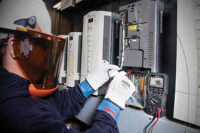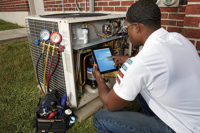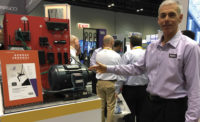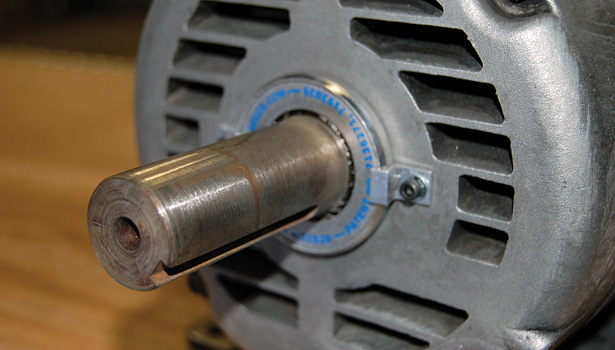Preventing Electrical Fluting in Motors
Ceramic Ball Bearings, Shaft Grounding Rings Help Mitigate Damage

Whenever possible, Greg Crumpton, president and founder of AirTight Mechanical Inc., Charlotte, N.C., said he prefers to add a grounding brush to VFD-driven motors. (Photo courtesy of AirTight)

Repeated discharges of inverter-induced shaft voltages can blast tiny pits in bearings on their way to ground, eventually forming frosting on the bearing race wall. In a similar phenomenon called fluting, pits are shaped into washboard-like ridges. In addition to the increased friction produced by frosting, fluting causes noise and vibration.(Photo courtesy of Electro Static Technology)

Electrical discharges from inverter-induced motor shaft voltages can release tiny metal particles that contaminate grease, intensifying abrasion. The resulting temperature rise can cause bearing grease to burn. (Photo courtesy of Electro Static Technology)



Variable-frequency drives, or VFDs, are becoming more commonplace in motor retrofits and new installations. And while they boast increased energy efficiency as the main benefit, a small — but by no means insignificant — percentage of the drives are causing major problems in the motor they control.
“A problem with VFDs and motors is a phenomenon called electrical fluting,” explained Nate Morse, technical team leader at AirTight Mechanical Inc., Charlotte, N.C. “This occurs in the bearings of the motor, and, as the bearing begins to fail, it sets up a vibration in the motor. The bearings will eventually fall apart, and that could cause a motor failure.”
Luckily, options exist to help prevent electrical fluting, which more and more contractors are beginning to routinely include in their VFD installations.
Check Your Equipment
While electrical fluting is not an uncommon problem, overheating due to improper sizing is an even more frequent issue. Before installing a VFD, a technician should verify that a motor is rated for a VFD and that the motor is operated at the suggested speeds.
“One of the biggest things you have to be sure of when you install a VFD on an existing motor is that the existing motor insulation will be able to handle higher temperatures,” Morse said. “If the motor is operated at speeds lower than its design, heat is generated. Normally, air would move the heat away from the motor, but if the motor is turning at slower speeds, the normal airflow across that motor would be less.”
Greg Crumpton, president and founder of AirTight, agreed with Morse. “Let’s say [the manufacturer] gives you minimum hertz recommended operating speed,” Crumpton said. “As long as you’re operating at or above that, then you’re within their guidelines. As long as you apply the right product in the right application, it’s not a problem.”
“If the motor that you’re going to be installing the drive on isn’t rated for inverter duty, then you have to change the motor,” Morse said. “You’ll end up changing it eventually, anyway.”
Electrical Fluting
Even in properly sized equipment, electrical fluting can occur. If left unattended, it can eventually result in motor failure.
“As the VFD changes the characteristics of the incoming voltage, the result of that can be — not always, but can be — that current and voltage is induced into the wires going to the motor beyond the normal operating voltage of the motor,” Morse explained. “It’s pretty crazy electrical engineering. That voltage and current is induced into the rotating part of the motor. It has to go somewhere.”
“The pitting that’s occurring because of these little electrical storms causes the bearings to pit,” Crumpton added. “It’s almost like a baby bolt of lightning. That’s how much energy builds up before it finds a path to ground. That’s what causes such a meltdown.”
Hank Bloom, owner, Environmental Conditioning Systems, Mentor, Ohio, said electrical fluting is “very common” and a “very big problem.” Crumpton said he personally sees it in about 15 percent of their applications.
“My understanding is that the electrical characteristics of the motor, the number of windings, the number of laminations in the rotor, the kind of wire that’s run between the motor and the drive — all of these things play a part in the way that this phenomenon occurs,” Morse added. “It’s not something that we can predict.”
Crumpton said they try to install shaft grounding rings on VFD-driven motors whenever possible, though it may not always be cost-effective. “We are a heck of a lot smarter than we were three or four years ago about it,” he said. “If we were doing a retrofit, we would include a grounding brush kit per drive.”
Preventing Further Damage
As VFD-driven motors continue to increase in popularity, contractors and manufacturers are working to find the most effective ways to mitigate the harmful effects of shaft voltage.
“There are some steps that you can take to prevent it from occurring again,” Morse said. “You can install ceramic bearings, which are made of steel and ceramic, so electricity can’t pass through them. The second is the shaft grounding ring; it’s attached to the motor housing and goes around the shaft, and it has carbon brushes that are in contact with the rotating shaft. That provides a very low resistance to ground. All of that electricity that is building up finds its way to ground very easily.”
Adam Willwerth, sales and marketing manager at Electro Static Technology, a manufacturer of shaft grounding rings, said the AEGIS® Bearing Protection Ring “provides a very low impedance path from shaft to ground, bypassing the motor’s bearings.” He added, “Installing an AEGIS ring on a new motor, or purchasing a motor with a factory-installed ring, is well worth the price, considering the costs of the downtime and repairs it will prevent.”
Bloom agreed that adding a grounding ring to the shaft is an effective way to prevent electrical fluting. “Some motor manufacturers are now grounding shafts from the factory,” he added.
Jerry Krych, manager, AAH Warranty Service at Daikin Applied, suggested using ceramic ball bearings and shaft grounding kits. “Today, most customers will order motors with shaft grounding kits to prevent shaft currents from damaging the motor bearings,” he said. “If it is a field issue, motors can be retrofitted with shaft grounding kits.”
Leandro Tarragona, application engineer at Danfoss, said shaft and bearing currents are inherent to the pulse-width modulation (PWM) mode of operation in VFDs. “An inverter duty motor — where the manufacturer already has taken measures to address this effect — should be used along with a best-practice installation,” Tarragona said. “This includes good grounding on both the drive and motor, and high-frequency, low-impedance bonding between the drive and the motor, which helps to provide a return path for the high-frequency harmonics produced by the PWM output. In extreme cases, a filter between the drive and the motor may be required.”
Mike Wolf, fan and vent product manager at Greenheck Fan Corp., also agreed that techs should consider “a motor with a shaft-grounding ring to avoid bearing failures.”
Crumpton said he and his employees are doing what they can to raise awareness of the problems that can occur in VFD-driven motors, as well as their solutions. But, he said they need some support from the people who make the products. “I would like to see the manufacturers offer some help with it,” he said. “I think we sell well when we educate first.” He added, “I know we’re not alone in this.”
Publication date: 12/9/2013
Want more HVAC industry news and information? Join The NEWS on Facebook, Twitter, and LinkedIn today!













